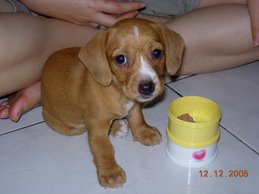2007 Pet Food Crisis (Wikipedia Current Event)
From Wikipedia, the free encyclopedia.
The 2007 pet food crisis comprises the contamination and wide recall of many brands of cat and dog foods beginning in March 2007 and the ensuing developments involving the human food supply. The recalls in North America, Europe, and South Africa came in response to reports of renal failure in pets. Initially the recalls were associated with the consumption of mostly wet pet foods made with wheat gluten from a single Chinese company. After more than three weeks of complaints from consumers, the recall began voluntarily with the Canadian company Menu Foods on March 16, 2007, when a company test showed sickness and death in some of the test animals. Soon after, there were numerous media reports of animal deaths as a result of kidney failure. In the following weeks, several other companies who received the contaminated wheat gluten also voluntarily recalled dozens of pet food brands. One month after the initial recall, contaminated rice protein from a different source in China was also identified as being associated with kidney failure in pets in the United States, while contaminated corn gluten was associated with kidney failure with pets in South Africa. As a result of investigating the 2007 pet food crisis a broader Chinese protein export scandal unfolded, raising concerns about the safety of the human food supply.
By the end of March, veterinary organizations reported more than 100 pet deaths amongst nearly 500 cases of kidney failure,[1] with one online database self-reporting as many as 3,600 deaths as of April 11.[2][3] The U.S. Food and Drug Administration has received reports of several thousand cats and dogs who have died after eating contaminated food, but have only confirmed 14 cases in part because there is no centralized government records database of animal sickness or death in the United States as there are with humans (such as the Centers for Disease Control).[4][5] As a result, many sources speculate that the actual number of affected pets may never be known and experts are concerned that the actual death toll could potentially reach into the thousands.[6][7]
By the end of March, veterinary organizations reported more than 100 pet deaths amongst nearly 500 cases of kidney failure,[1] with one online database self-reporting as many as 3,600 deaths as of April 11.[2][3] The U.S. Food and Drug Administration has received reports of several thousand cats and dogs who have died after eating contaminated food, but have only confirmed 14 cases in part because there is no centralized government records database of animal sickness or death in the United States as there are with humans (such as the Centers for Disease Control).[4][5] As a result, many sources speculate that the actual number of affected pets may never be known and experts are concerned that the actual death toll could potentially reach into the thousands.[6][7]
Overall, several major companies have recalled more than 5300 pet food products, with most of the recalls coming from Menu Foods.[4] Although there are several theories of the source of the agent causing sickness in affected animals, with extensive government and private testing and forensic research, to date, no definitive cause has been isolated. As of April 10, the most likely cause, according to the FDA, though not yet proven, is contamination indicated by the presence of melamine in the ingredients of the affected foods. The Chinese company behind the contaminated wheat gluten has initially denied any involvement in the contamination, but is cooperating with Chinese and American investigators.
In the United States, there has been extensive media coverage of the recall. There has been widespread public outrage and calls for government regulation of pet foods, which had previously been self-regulated by pet food manufacturers. The United States Senate held an oversight hearing on the matter by April 12. [8] The economic impact on the pet food market has been extensive, with Menu Foods losing roughly $30 million alone from the recall. There have been several waves of recalls, many issued late on Friday evenings possibly to avoid media coverage, and the events have caused distrust in some consumers.[9]
Reports of widespread and possibly intentional adulteration of Chinese animal feed with melamine have raised the issue of melamine contamination in the human food supply both in China and abroad.[10] On April 27 US FDA subjected all vegetable proteins imported from China, intended for human or animal consumption, to detention without physical examination, including: Wheat Gluten, Rice Gluten, Rice Protein, Rice Protein Concentrate, Corn Gluten, Corn Gluten Meal, Corn By-Products, Soy Protein, Soy Gluten, Proteins (includes amino acids and protein hydrosylates), and Mung Bean Protein.[11] In a teleconference with reporters on May 1, officials from the FDA and U.S. Department of Agriculture said that between 2.5 and 3 million people in the United States had consumed chickens that had consumed feed containing contaminated vegetable protein from China.[12]
Current research has focused on the combination of melamine and cyanuric acid in causing renal failure. Reports that cyanuric acid may be an independently and potentially widely used adulterant in China have heightened concerns for both pet and human health.[13]
As of May 7, United States food safety officials stated: "There is very low risk to human health from consuming meat from hogs and chickens known to have been fed animal feed supplemented with pet food scraps that contained melamine and melamine-related compounds"[14]















.jpg)






.jpg)

0 comments:
Post a Comment